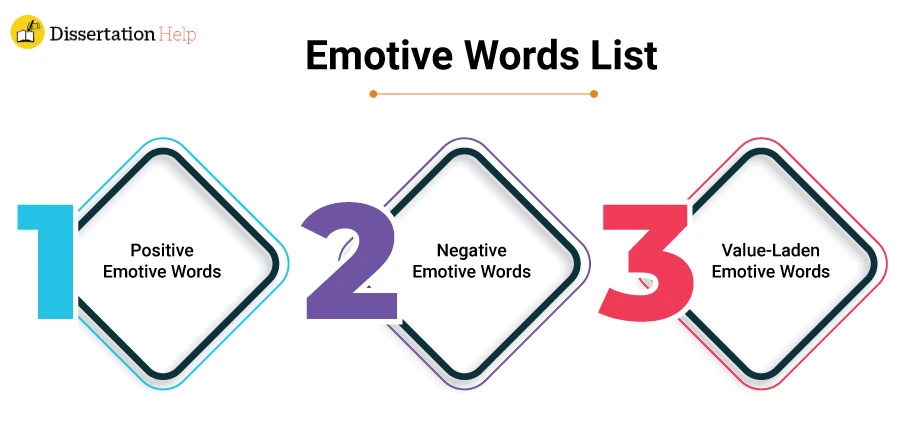
Can you imagine life without emotions? In our life, emotions play a vital role. Most importantly, when it comes to verbal and written communication, you can transfer emotions to the listeners and readers in the form of words. Are you wondering how to emote with the help of words? You can use emotive language. Basically, emotive language is a type of language that is used to transmit emotions through words or sentences. It is a powerful language technique that will add more value to the content. Also, with the help of emotive language, you can share your thoughts and convince the target audience by evoking their feelings.
Do you want to know more about emotive language? If yes, then continue reading this blog post. Here, we have explained the definition of emotive language along with its significance, uses, and examples in real life and literature. Also, we have suggested some effective ways to use emotive language in your writing.
Go through the entire blog post and gain a complete understanding of emotive language.
What is Emotive Language?
Emotive language is defined as a language that brings out emotions using emotions. In simple terms, it is identified as words that are used to stir up the emotions of the readers or listeners. To make your content effective, you can use emotive language carefully by selecting the best words that pass the emotions to the readers.
The main aim of emotive language is to build an effect on the people. You can very well use emotive language techniques while writing a research essay topic or narrating a story. In order to connect the readers or listeners with the speaker or writer, this technique mainly uses emotions.
Say, for example, when you convey information in an emotional way, it will quickly reach the subconscious mind of the listeners or readers. Thus, in turn, it will also become easy for the target audience to memorize the content delivered.

Emotive Words List
Till now, we saw the definition of emotive language. Next, let us have a look at the list of emotive words.
In general, emotive language links the readers with the writers. It particularly deals with the variety of words or phrases that are used to communicate an emotion. The words can be emotive adjectives, verbs, adverbs, and abstract nouns. The emotive words can be positive or negative too.
Listed below are some strong emotive words that you can use to elevate your writing.
Positive Emotive Words
Positive emotive words are words that express a positive feeling of happiness or thankfulness. It mainly spreads pleasant emotions or responses in the environment. Mentioned below are some popular positive emotive words.
- Serenity
- Amusement
- Joy
- Gratitude
- Interest
- Hope
- Pride
Negative Emotive Words
Words that describe the feeling of sadness or misery are referred to as negative emotive words. Usually, the negative words create a negative effect, unpleasant emotions, or unhappiness. Here are a few important negative emotive words.
- Anger
- Sadness
- Annoyance
- Rage
- Fear
- Disgust
- Loneliness
Value-Laden Emotive Words
The words that express positive or negative opinions or biases toward the subject are called value-laden emotive words. Mostly, these words reflect the bias of the author. Sometimes it is also identified as loaded words. Listed below are some value-laden emotive words.
- Innocent
- Valuable
- Guilt
- Vital
Emotive Language Examples
Below we have shared some interesting emotive language examples. Have a look at it and get a better understanding of how emotive sentences differ from non-emotive sentences of the same meaning.
For instance, let us take two simple sentences and see the difference between them.
Sentence 1: Put the plastic water bottle in the recycle bin.
Sentence 2: Plastic recycling saves the planet and hence always put the plastic wastes in the recycle bin.
Both the sentences mentioned above insist to drop the plastic wastes into the recycle bin. But sentence 1 sounds commanding and it doesn’t bring out emotions. Hence, you can’t call sentence 1 an emotive sentence. Sentence 1 is just an ordinary sentence without any emotions. On the other hand, sentence 2 entirely appears different. In sentence 2, action is suggested along with emotion and it also brings out an emotional reaction. Therefore, sentence 2 is considered to be an emotive sentence.
Here are a few more interesting examples of emotive language.
Example 1:
Non-Emotive Sentence: The truck hit the pedestrian.
Emotive Sentence: The truck viciously crushed the poor pedestrian.
In this example, the accident is not hyped in the first sentence and hence it will not raise any emotions in the readers. But when the same event is described with emotive words like viciously crushed, a sympathetic emotion will evoke.
Example 2:
Non-Emotive Sentence: A passenger was murdered on the train.
Emotive Sentence: An innocent passenger was brutally murdered on the train.
Similar to example 1, here the non-emotive sentence is less descriptive. Also, it doesn’t convey emotions. But in the emotive sentence, the words, ‘innocent and brutally murdered’ describe the events in detail and also generate an emotion.
Example 3:
Non-Emotive Sentence: The rabbits were hunted.
Emotive Sentence: The rabbits were cruelly slaughtered.
Here, in the non-emotive sentence, the act of hunting doesn’t express any emotions. But when it is explained using the words ‘brutally slaughtered’ an intense meaning is delivered to the readers about the cruel activity.
Example 4:
Non-Emotive Sentence: She was badly injured in the fire accident.
Emotive Sentence: She was left with horrific injuries in the fire accident.
In the non-emotive sentence, badly injured just denotes critical injury, whereas it doesn’t specify the seriousness of the injury to the readers. But the term ‘horrific injury’ in the emotive sentence stirs up the emotions. Also, it explains the severity of the injury to the readers.
Example 5:
Non-Emotive Sentence: The bride entered the marriage hall in a gown.
Emotive Sentence: The adorable bride entered the marriage hall in a gorgeous gown.
As the beauty of the bride was not described, it fails to create an emotion. But, in the emotive sentence, the words, ‘adorable and gorgeous’ highlight the girl’s beauty and attire, and thus kindle positive emotions.
Similar to the usage of emotive words in the emotive language examples shared above, you can also use either positive or negative emotive words in your real-time conversation. Note that, with the help of appropriate emotive words you can effectively convert a normal sentence into an emotive one. More commonly, literary writers and poets use emotive language to communicate their ideas and thoughts.
Emotive Language Uses in Real Life
For using emotive language, there are no restrictions. You can apply the emotive language technique in all forms of spoken as well as written work such as
- Debate
- Biographies
- Speech
- Daily conversation
- Address Books
- Promotions
- Advertising trademarks
- Newspaper articles
- Novels
- Films
- Short stories
- Diaries
- Poetry
- Personal blogs
- Opinion pieces
- Plays
- Public Announcements
Businesses widely use emotive language for marketing and promotions. Especially in order to attract the target customers by touching their emotions, they work with emotive language in their advertising materials. Other than that, the creators in the field of art such as films, drama, books, poems, and novels also extensively use emotive language to narrate a story of life and try to transfer the emotion of characters to the readers. Besides, you can also prefer emotive language to write personal diaries and autobiographies that contain a lot of sentiments.
Emotive Language Benefits
As the emotive language technique has numerous benefits, you can very well make use of it in your daily life. Here are some key benefits that you can get when you apply emotive language in your speaking or writing.
- It engages the listeners and readers.
- The emotive language behaves like an expressive tool.
- It clearly presents the information of the writer.
- Using emotive language helps the speaker or writer to get a strong reaction or response from the target audience.
- It provides a cultural background.
- The emotive language has the power to inspire the readers’ emotions.
- It makes it easy for people to connect with the characters involved in stories or events.
How to Develop Emotive Language Writing Skills?
Are you worried about how to develop your writing abilities to effectively communicate emotions? Don’t worry! Generally, when it comes to using emotive language, identifying a perfect emotive word is one major problem faced by many writers. So, you should mainly build your emotional jargon.
In order to develop your emotive language writing skills, you can very well read articles or books that have used emotive language techniques to convey thoughts or ideas. Because, when you go through various sources, you will get plenty of emotive words to share your emotions or a character’s feelings in a story.
Emotive Language Effects
The aim of emotive language is to influence the target audience. Note that, if you apply emotive language techniques in a proper way, you can smartly shape the reaction of the target audience.
As emotive language is one of the popular persuasive writing techniques, you can use it to convince the audience. But, sometimes, it will make the crowd raise questions against you, if you are a speaker or a writer. In such situations, things will flip upside down and you may end up making a blunder. Therefore, never overuse emotive language in your work.
Emotive Language Examples in Literature
Every writer has a purpose to write literature. But mostly they craft literature to share their thoughts and ideas with the readers. While writing content for strangers, mainly to attract them, it is necessary to present the thoughts in a way that is relatable to them. That is the reason why authors commonly apply language techniques in the literature.
Emotive language is one of the popular language techniques many literary writers prefer to evoke emotions. You can also find the usage of emotive language in the already published literature, novels, poems, and stories too.
Here, let us see how emotive language is implemented in literature.
Example 1: Shakespeare’s Sonnet 18
Poetry is one of the popular modes of exhibiting emotions or feelings through descriptive words. When speaking about poetry, we can’t overlook the literature works of William Shakespeare.
Especially in Sonnet 18, Shakespeare has used emotive language effectively. Here, let us analyze an excerpt from Shakespeare’s Sonnet 18.
Shall I compare thee to a summer’s day?
Thou art more lovely and more temperate:
…
And every fair from fair sometimes declines,
By chance or nature’s changing course untrimm’d;
But thy eternal summer shall not fade,
Nor lose possession of that fair thou ow’st;
In this, Shakespeare has used emotive language to compare his love interest to a summer day that will never fade. Also, he has used emotive words like ‘lovely and temperate’ in the second line of the sonnet to describe a person and raised an argument that the person is far better than the summer’s best day you could experience.
Example 1: Speech of Martin Luther King, Jr
“I Have a Dream”
This is a short excerpt from the Civil Rights Speech of Martin Luther King, Jr in 1963.
The name “Martin Luther King” is sufficient to break into the contemporary world. The majority of us know about the world where the great Martin Luther King lived and his life principles. So, when reading this sentence from his speech, you can easily connect with his background.
Here, let us analyze the excerpt.
The incomparable Martin Luther King, Jr. with his effective rhetoric gets emotional responses from his audience. One strong persuasive technique he has used in his speech is emotive language.
Here, we will explain to you how with a simple excerpt from his speech.
“One hundred years later the life of the Negro is still badly crippled by the manacles of segregation and the chains of discrimination. One hundred years later the Negro lives on a lonely island of poverty in the midst of a vast ocean of material prosperity.”
In this excerpt, King Jr. has applied emotive language to stir the emotions of the listeners. His expectation was to make the audience feel bothered and realize the need for action. Mainly, to influence the listeners to participate in the Civil Rights Movement, he has effectively used emotive language in his speech.
Connotations and Emotive Language
Note that, the emotive words alone will not make the language complete. Another key concept that adds value to the language is the connotations. Similar to emotive language, connotations are also a persuasive language technique. You can also use them in your written piece to convince your readers.
If you apply connotation and emotive language properly in your work, then it will not become too hard for you to influence your readers. In a text, you can easily spot both techniques. However, there are still a few exceptions. At certain times, you may find it difficult to understand the meaning of the words. Therefore, mainly to evaluate the use of connotation and emotive language, it is necessary to have prior knowledge about these two techniques.
If you want to learn and understand connotations and also need to know how to analyze emotive language and connotation, then keep on reading the blog post.
What is Connotation?
Connotation is a method of displaying an additional meaning of a word or a set of words beyond the regular literary explanation. In other words, it is an emotion or idea carried by a word or a phrase along with its literal meaning. By using connotations, the writers or speakers refer to “what is advised or implied”.
In a language, the usage of words plays a major role. We have infinite words with their own meanings and associations. Therefore, we should select the words carefully as they are the only medium we can use to convince the audience and evoke a particular emotion or reaction.
Examples of Connotation
Listed below are a few connotation examples.
One of the simplest ways to grasp the concept of connotations is through color association. Basically, each color represents some emotions and has a unique interpretation.
Say, for example,
- White symbolizes peace and purity.
- Black stands for death.
- Red denotes danger, anger, aggression, and passion.
Connotation Examples in Literature
A connotation is a popular language feature, many literary writers use in their writing. But they purposely use connotations to point out a specific association. Here, let us take a close look at the speech of Elizabeth I.
I know I have the body but of a weak and feeble woman, but I have the heart and stomach of a king …’
This is one of the famous excerpts from the speech of Elizabeth I regarding inspirational strengths and physical limitations. In the excerpt, the words “heart and stomach” are connotations. Mainly, she has used these words to refer to her valiance, courage, and spirit.
Through her choice of words, the listeners can easily get to know about the core speech content. In her speech, she clearly describes herself as a woman without the physical attributes of a man but who possesses inner strength and courage. Also, she compares herself to a King and portrays her as a woman in the men’s world who can stand independently for her people.
Analysis of Emotive Language and Connotation
We hope you are now clear with the concepts of connotation and emotive language. Next, let us step forward and see how to analyze connotation and emotive language.
Below is a detailed explanation of the analysis.
Pay attention to the speaker’s intention
At first, you should focus on the intention of the speaker or writer. So, explore and find out the emotional reaction the writers or speakers want from the listeners or readers. Say, for example, it can be happiness or rage, pride or pity, etc.
Explore the purpose and reaction of the audience
Secondly, analyze and find how the emotional reaction of the audience relates to the overall purpose of the writers.
Placement
It is also an aspect to focus on while evaluating the language techniques. If a writer starts with an angry phrase, then the target audience may get angry. So, it is important to consider emotive language in the context of the purpose that you want to include in your writing.
While you analyze the emotive language and connotations, make sure to find answers to the following questions.
- How does the use of emotive language change as per the purpose?
- What type of connotations would the various readers react to?
- Does the emotive language soften or arouse depending on the discussion?
At the time of evaluation, specifically, keep in mind the factors such as political interests, religious beliefs, socio-economic factors, and age, the emotive language and connotations can have on the readers. Remember, each individual has their own viewpoints and that is why several meanings are generated from the same text.
Final Words
We believe that the explanations and examples in this blog post about emotive language will help you to craft extraordinary writing work. Note that, preparing content by using innovative language techniques is not an easy task to handle. Once you finish writing your draft, without fail proofread and edit the entire work to avoid unnecessary errors.
In case, you have no idea how to use emotive language in your writing, quickly contact us for online assignment writing help. In our team, we have professional writers who are experts in language to assist you in completing language assignments.
To make use of our assignment writing service, simply share your requirements with us. As per your writing specifications, we will prepare and deliver you plagiarism-free, high-quality content on time at a reasonable price.
Do you need cheap and best language assignment writing help? Are you looking for an excellent online academic writing service or online dissertation help? Call us now! Our experts will provide outstanding writing solutions for all the assignment writing issues you face on any subject topic.
Just book your order and get the necessary academic benefits at an easy go.




